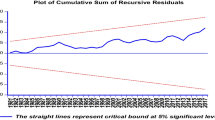Abstract
Both inflation and inflation expectations declined considerably in the inflation targeting countries during the past two decades. The questions of whether this decline has actually been an outcome of inflation targeting solely and whether inflation targeting has been successful in stabilizing other macroeconomic variables though remain. This study considers these questions on the basis of 16 inflation targeting countries and 21 non-targeting ones using a difference-in-difference approach. With regard to the baseline period of 1996–1999 during which neither of the groups was implementing inflation targeting, a difference-in-difference approach was employed to assess the effects of inflation targeting on inflation, output growth, real exchange rates, inflation volatility and real exchange rate volatility during moving 4-year periods between 2007 and 2015. Our estimates suggest that inflation targeting was superior in terms of harnessing inflation as well as inflation volatility. In terms of economic growth, however, inflation targeting seems to be neutral and in terms of real exchange rates it seems not to be stabilizing, if not de-stabilizing. A hybrid version of inflation targeting, namely the conventional inflation targeting augmented by an improved capacity to deliver macro-prudence as in the post-Lehman economic climate, can therefore be viewed as the best available policy alternative for the upcoming decades.

Similar content being viewed by others
Notes
The inflation targeting countries with their years of adoption are as follows: New Zealand (1990), Canada (1991), United Kingdom (1992), Sweden (1993), Australia (1993), Czech Republic (1997), Israel (1997), Poland (1998), Brazil (1999), Chile (1999), Colombia (1999), South Africa (2000), Thailand (2000), South Korea (2001), Mexico (2001), Iceland (2001), Norway (2001), Hungary (2001), Peru (2002), Philippines (2002), Guatemala (2005), Indonesia (2005), Romania (2005), Turkey (2006), Serbia (2006), Ghana (2007) and the Euro area countries, common monetary policy of which is conducted by the European Central Bank.
From a technical point of view, inflation targeting central banks announce official inflation targets and their mandates attribute topmost priority to those targets. Everyday conduct of monetary policy, though, is based on continuous surveillance of economic data and periodic forecasts which function as a dynamic compass for monetary authorities. Svensson (1997, 1998) and Svensson and Woodford (2003) can be seen for technicalities of inflation-forecast targeting.
As a minor note, in the cases of monetary aggregates and reserve requirements, what was called ‘unconventional’ has been nothing but the ‘conventional’ of the mid-twentieth century macroeconomics.
The assumption that the two groups start at identical points slightly complicates the graphical exposition, but the logic remains essentially the same.
References
Ball L, Sheridan N (2005) Does inflation targeting matter? In: Bernanke BS, Woodford M (eds) The inflation-targeting debate. University of Chicago Press, Chicago, pp 249–276
Batini N, Kuttner K, Laxton D (2005) Does inflation targeting work in emerging markets? IMF—World Economic Outlook, Chapter 4
Bernanke BS, Laubach T, Mishkin FS, Posen AS (1999) Inflation targeting: lessons from the international experience. Princeton University Press, Princeton
Blinder AS (1998) Central banking in theory and practice. MIT Press, Cambridge
Bruno M (1990) High inflation and the nominal anchors of an open economy. NBER Working Paper Series 3518
Cecchetti SG, Flores-Lagunes A, Krause S (2006) Has monetary policy become more efficient? A cross-country analysis. Econ J 116:408–433
Dotsey M (2006) A review of inflation targeting in developed countries. Fed Reserve Bank Phila Bus Rev Third Quarter:10–20
Freedman C (2005) Inflation targeting: some history and some issues. In: Presentation at the Central Bank of Turkey, 2 June 2005
Gonçalves CE, Salles JM (2008) Inflation targeting in emerging economies: what do the data say? J Dev Econ 85(1–2):312–318
Hansen BE (1999) The grid bootstrap and the autoregressive model. Rev Econ Stat 81(4):594–607
Johnson DR (2002) The effect of inflation targeting on the behavior of expected inflation: evidence from an 11 country panel. J Monet Econ 49(8):1521–1538
Kumhof M (2002) A critical view of inflation targeting: crises, limited sustainability and aggregate shocks. In: Loayza N, Soto R (eds) Inflation targeting: design, performance, challenges. Central Bank of Chile, Santiago
Levin AT, Natalucci FM, Piger JM (2004) The macroeconomic effects of inflation targeting. Fed Reserve Bank St. Louis Rev 86(4):51–80
Lin Shu, Ye Haichun (2007) Does inflation targeting really make a difference? Evaluating the treatment effect of inflation targeting in seven industrial countries. J Monet Econ 54(2007):2521–2533
Lin Shu, Ye Haichun (2009) Does inflation targeting make a difference in developing countries? J Dev Econ 89(2009):118–123
Mishkin FS, Schmidt-Hebbel K (2007) Does inflation targeting make a difference. In: Mishkin F, Schmidt-Hebbel K (eds) Monetary policy under inflation targeting, vol XI. Banco Central de Chile, Santiago, pp 291–372
Paulin G (2006) Credibility with flexibility: the evolution of inflation-targeting regimes, 1990–2006. Bank Can Rev 2006(Summer):5–18
Roger S (2010) Inflation targeting turns 20. Finance Dev 2010:46–49
Roger S, Restrepo J, Garcia C (2009) Hybrid inflation targeting regimes. IMF Working Paper 09/234
Sherwin M (1999) Inflation targeting: 10 years on. In: Speech to the New Zealand Association of Economists Conference, Reserve Bank of New Zealand, Rotorua, 1 July
Stock JH (1991) Confidence Intervals for the largest autoregressive root in U.S. macroeconomic time series. J Monet Econ 28(3):435–459
Svensson LEO (1997) Inflation forecast targeting: implementing and monitoring inflation targets. Eur Econ Rev 41(6):1111–1146
Svensson LEO (1998) Inflation targeting as a monetary policy rule. NBER Working Paper Series 6790
Svensson LEO, Woodford M (2003) Implementing optimal policy through inflation-forecast targeting. NBER Working Paper Series 9747
Vega M, Winkelried D (2005) Inflation targeting and inflation behavior: a successful story? Int Cent Bank 1(3):153–175
Author information
Authors and Affiliations
Corresponding author
Rights and permissions
About this article
Cite this article
Kose, N., Yalcin, Y. & Yucel, E. Performance of inflation targeting in retrospect. Empirica 45, 197–213 (2018). https://doi.org/10.1007/s10663-016-9357-z
Published:
Issue Date:
DOI: https://doi.org/10.1007/s10663-016-9357-z




